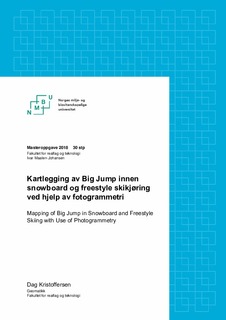| dc.contributor.advisor | Maalen-Johansen, Ivar | |
| dc.contributor.advisor | Gilgien, Matthias Felix | |
| dc.contributor.author | Kristoffersen, Dag Widerøe | |
| dc.date.accessioned | 2018-11-12T09:03:36Z | |
| dc.date.available | 2018-11-12T09:03:36Z | |
| dc.date.issued | 2018 | |
| dc.identifier.uri | http://hdl.handle.net/11250/2571932 | |
| dc.description.abstract | Eliteutøvere innen snowboard og freestyle skikjøring er utsatt for skader på store hopp. Derfor har det Internasjonale Skiforbundet (FIS) satt i gang et arbeid for å bygge disse hoppene slik at det skal bli færre tilfeller av skader.
En del av dette arbeidet er å kartlegge hvor utøverne lander i konkurransesituasjoner. Denne oppgaven tar for seg denne utfordringen.
Et FIS-stevne i Mönchengladbach i Tyskland 2. og 3. desember 2016 ble filmet med videokamera fra to ulike vinkler. Filene ble prosessert i Dartfish for videre bruk. Målinger av punkter rundt bakken ble også funnet med GNSS-utstyr.
Til å finne landingspunktene er den fotogrammetriske metoden Direct Linear Transformation brukt. Denne metoden finner koordinater til punkt ved å se punktet fra to ulike vinkler. Gjennom en kalibrering der en bruker kjentpunkt, finner en parameterne. Disse parameterne brukes til å finne koordiner til nye, ukjente punkt.
For å få til dette er Matlab-kodene DLTcal5.m og DLTdv5.m brukt. Ved å bruke de innmålte kjentpunktene og to videofiler er parameterne funnet. Ved å legge inn et filmsett av to videoer for hvert hopp er landingspunkt beregnet.
Det viste seg at det ikke var mulig å beregne landingspunktene med gode nok tall fra konkurransen i Mönchengladbach. Koordinatene som ble beregnet var ikke i landingsområdet. Grunnene til at dette ikke fungerte er en usikkerhet rundt kvaliteten på kalibreringspunktene, og en utfordring med synkroniseringen av hoppene.
Ved å kopiere metoden som er beskrevet i denne oppgaven, kan en allikevel benytte metoden senere. Det anbefales å teste ut metoden i mindre skala før den brukes i andre konkurranser. | nb_NO |
| dc.description.abstract | Elite athletes in Snowboard and Freestyle skiing are exposed to injuries at big jumps. Therefore, the International Ski Federation (FIS) has launched a work to build these jumps so that there will be fewer cases of injuries.
A part of this work is to map out where the athletes land in competitive situations. This task addresses this challenge.
A FIS-competition in M onchengladbach in Germany on the 2nd and 3rd of December 2016 was lmed with video camera from two di erent angles. The les were processed in Dart sh for further use. Measurements of points around the ground was also made with GNSS equipment.
To find the landing points, the photometric method Direct Linear Transformation is used. This method fi nds coordinates to points by viewing a point from two different angles. Through a calibration where one uses known points, the parameters are found. These parameters are used to fi nd coordinates for new, unknown points.
To achieve this, the Matlab codes DLTcal5.m and DLTdv5.m are used. By using the measured points and two video les, the parameters are found. By entering a set of two movies for each jump, landing points is calculated.
It turned out that it was not possible to calculate the landing points with good numbers from the competition in Mönchengladbach. The coordinates that were calculated were not in the landing area. The reasons why this did not work is an uncertainty about the quality of the calibration points, and a challenge with the synchronization of the jumps.
By copying the method described in this task, one can still use the method later. It is recommended to test the method on a smaller scale before it is used in other competitions. | nb_NO |
| dc.language.iso | nob | nb_NO |
| dc.publisher | Norwegian University of Life Sciences, Ås | nb_NO |
| dc.rights | Attribution-NonCommercial-NoDerivatives 4.0 Internasjonal | * |
| dc.rights.uri | http://creativecommons.org/licenses/by-nc-nd/4.0/deed.no | * |
| dc.title | Kartlegging av Big Jump innen snowboard og freestyle skikjøring ved hjelp av fotogrammetri | nb_NO |
| dc.title.alternative | Mapping of big jump in snowboard and freestyle skiing with use of photogrammetry | nb_NO |
| dc.type | Master thesis | nb_NO |
| dc.subject.nsi | VDP::Teknologi: 500 | nb_NO |
| dc.source.pagenumber | 98 | nb_NO |
| dc.description.localcode | M-GEOM | nb_NO |

